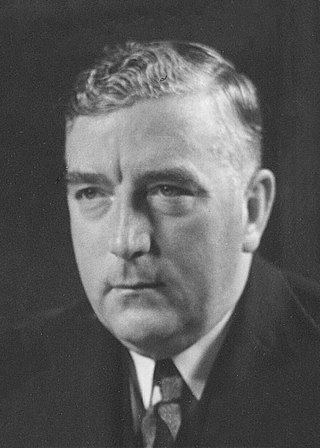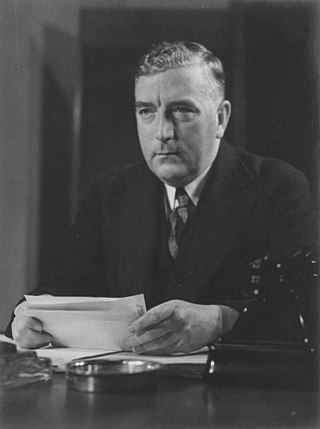
The United Australia Party (UAP) was an Australian political party that was founded in 1931 and dissolved in 1945. The party won four federal elections in that time, usually governing in coalition with the Country Party. It provided two prime ministers: Joseph Lyons (1932–1939) and Robert Menzies (1939–1941).

Sir John McEwen was an Australian politician and farmer who served as the 18th prime minister of Australia from 1967 to 1968, in a caretaker capacity following the disappearance of prime minister Harold Holt. He was the leader of the Country Party from 1958 to 1971, serving as the inaugural deputy prime minister of Australia from 1968 to 1971.

Archie Galbraith Cameron was an Australian politician. He was a government minister under Joseph Lyons and Robert Menzies, leader of the Country Party from 1939 to 1940, and finally Speaker of the House of Representatives from 1950 until his death.

The Scullin ministry (Labor) was the 19th ministry of the Government of Australia. It was led by the country's 9th Prime Minister, James Scullin. The Scullin ministry succeeded the Third Bruce ministry, which dissolved on 22 October 1929 following the federal election that took place on 12 October which saw Labor defeat Stanley Bruce's Nationalist–Country Coalition. The ministry was replaced by the First Lyons ministry on 6 January 1932 following the federal election that took place in December which saw the United Australia Party defeat Labor. As of 2022, it remains the most recent government to have lost an election after a single term in office.

The Third Lyons ministry was the 22nd ministry of the Government of Australia. It was led by the country's 10th Prime Minister, Joseph Lyons. The Third Lyons ministry succeeded the Second Lyons ministry, which dissolved on 9 November 1934 after Lyons entered into a formal Coalition with Earle Page and his Country Party; the second such coalition after that of the Bruce government. The ministry was replaced by the Fourth Lyons ministry on 29 November 1937 following the 1937 federal election.

The Fourth Lyons ministry was the 23rd ministry of the Government of Australia. It was led by the country's 10th Prime Minister, Joseph Lyons. The Fourth Lyons ministry succeeded the Third Lyons ministry, which dissolved on 29 November 1937 following the federal election that took place in October. The ministry was replaced by the Page ministry on 7 April 1939 following the death of Lyons - the first of three occasions where a sitting Prime Minister died in office.

The Page ministry was the 24th ministry of the Government of Australia. It was led by the country's 11th Prime Minister, Sir Earle Page. The Page ministry succeeded the Fourth Lyons ministry, which dissolved on 7 April 1939 following the death of former Prime Minister Joseph Lyons - the first of three occasions where a sitting Prime Minister died in office. Since Page was the head of the Country Party, it was a caretaker ministry until the senior partner in the Coalition, the United Australia Party, could elect a new leader. Former Attorney-General Robert Menzies was ultimately elected on 18 April 1939. However, due to the Country Party withdrawing from the Coalition after relations between Page and Menzies broke down, Menzies along with his ministry was not sworn in until 26 April 1939.

The First Menzies ministry was the 25th ministry of the Government of Australia. It was led by the country's 12th Prime Minister, Robert Menzies. The First Menzies ministry succeeded the Page ministry, which dissolved on 26 April 1939 following the election of Menzies as UAP leader after the death of former Prime Minister Joseph Lyons. However, due to the Country Party withdrawing from the Coalition after relations between caretaker Prime Minister Sir Earle Page and Menzies broke down, the First Menzies ministry was composed solely of UAP ministers, and was effectively a minority government. The ministry was replaced by the Second Menzies ministry on 14 March 1940 after Menzies took the Country Party back into his government - now led by Archie Cameron.

The Second Menzies ministry was the 26th ministry of the Government of Australia. It was led by the country's 12th Prime Minister, Robert Menzies. The Second Menzies ministry succeeded the First Menzies ministry, which dissolved on 14 March 1940 after Menzies entered into a formal Coalition with Archie Cameron and his Country Party. The ministry was replaced by the Third Menzies ministry on 28 October 1940 following the 1940 federal election.

The Third Menzies ministry was the 27th ministry of the Government of Australia. It was led by the country's 12th Prime Minister, Robert Menzies. The Third Menzies ministry succeeded the Second Menzies ministry, which dissolved on 28 October 1940 following the federal election that took place in September. However, as a result of that election the government was reduced to minority status, and were forced to rely on the votes of independent crossbenchers Alexander Wilson and Arthur Coles to survive. The ministry was replaced by the Fadden ministry on 28 August 1941 following the resignation of Menzies.

The Fadden ministry was the 28th ministry of the Government of Australia. It was led by the country's 13th Prime Minister, Arthur Fadden. The Fadden ministry succeeded the Third Menzies ministry, which dissolved on 28 August 1941 following the resignation of Robert Menzies as Prime Minister. A subsequent joint meeting of the Coalition parties elected Country leader Fadden as Menzies' successor. The ministry was replaced by the First Curtin ministry on 7 October 1941 after the independent crossbenchers Alexander Wilson and Arthur Coles withdrew their support for the Fadden government and voted with John Curtin and his Labor Party to bring the government down in a de facto no-confidence motion.

The Fourth Menzies ministry was the 34th ministry of the Government of Australia. It was led by the country's 12th Prime Minister, Robert Menzies. The Fourth Menzies ministry succeeded the Second Chifley ministry, which dissolved on 19 December 1949 following the federal election that took place on 10 December which saw the Coalition defeat Ben Chifley's Labor Party. The ministry was replaced by the Fifth Menzies ministry on 11 May 1951 following the 1951 federal election.

The Sixth Menzies ministry was the 36th ministry of the Government of Australia. It was led by the country's 12th Prime Minister, Robert Menzies. The Sixth Menzies ministry succeeded the Fifth Menzies ministry, which dissolved on 9 July 1954 following the federal election that took place in May. The ministry was replaced by the Seventh Menzies ministry on 11 January 1956 following the 1955 federal election.

The Tenth Menzies ministry was the 40th ministry of the Government of Australia. It was led by the country's 12th Prime Minister, Sir Robert Menzies. The Tenth Menzies ministry succeeded the Ninth Menzies ministry, which dissolved on 18 December 1963 following the federal election that took place in November. The ministry was replaced by the First Holt ministry on 26 January 1966 following the retirement of Menzies.

The First Holt Ministry was the 41st ministry of the Government of Australia. It was led by the country's 17th Prime Minister, Harold Holt. The First Holt ministry succeeded the Tenth Menzies ministry, which dissolved on 26 January 1966 following the retirement of former Prime Minister Sir Robert Menzies. The ministry was replaced by the Second Holt ministry on 14 December 1966 following the 1966 federal election.

Sir Eric John Harrison, was an Australian politician and diplomat. He was the inaugural deputy leader of the Liberal Party (1945–1956), and a government minister under four prime ministers. He was later High Commissioner to the United Kingdom from 1956 to 1964.

The Menzies government (1949–1966) refers to the second period of federal executive government of Australia led by Prime Minister Robert Menzies. It was made up of members of a Liberal–Country Party coalition in the Australian Parliament from 1949 to 1966. Menzies led the Liberal–Country Coalition to election victories in 1949, 1951, 1954, 1955, 1958, 1961 and 1963. Robert Menzies was Australia's longest serving prime minister. He had served a previous term as prime minister as leader of the United Australia Party from 1939 to 1941. Although he would retire in 1966, his party would remain in office until 1972, an unprecedented 23 years of government from nine consecutive election victories.

The Menzies government (1939–1941) refers to the federal executive government of Australia led by Prime Minister Robert Menzies. Menzies led the United Australia Party in the Australian Parliament from 1939 to 1941. Menzies served a later and longer term as prime minister as leader of a successor party, the Liberal Party of Australia from 1949 to 1966.

The Lyons government was the federal executive government of Australia led by Prime Minister Joseph Lyons. It was made up of members of the United Australia Party in the Australian Parliament from January 1932 until the death of Joseph Lyons in 1939. Lyons negotiated a coalition with the Country Party after the 1934 Australian federal election. The Lyons government stewarded Australia's recovery from the Great Depression and established the Australian Broadcasting Corporation.

The Fadden government was the federal executive government of Australia led by Prime Minister Arthur Fadden, as leader of the Country Party. He was appointed prime minister on 29 August 1941, during World War II, following the resignation of Robert Menzies of the United Australia Party (UAP). Fadden continued the coalition government between the Country Party and the UAP, but after just over one month in office the government was defeated on a confidence motion. Fadden was succeeded as prime minister on 7 October 1941 by John Curtin of the Australian Labor Party (ALP).


































